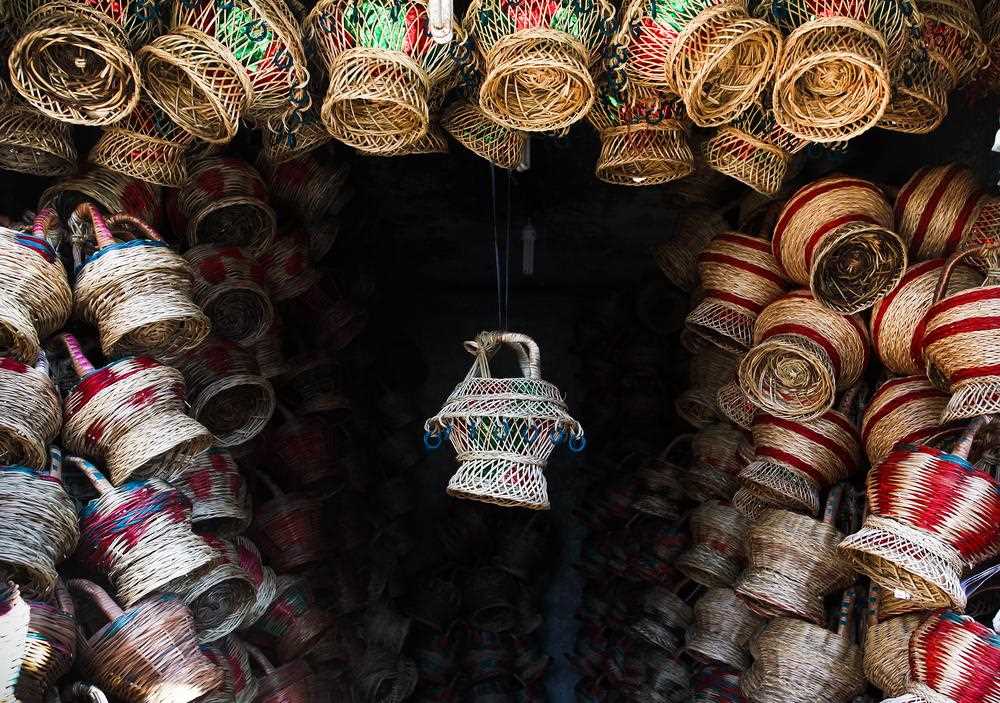
'Kangri,' commonly called Kanger in Kashmir, is a traditional earthen pot in a woven wicker basket and filled with red-hot charcoal.
Kashmiris carry it inside the 'Pheran,' a traditional long flowing tweed over-garment, to keep the freezing winter away.
As most of rural Kashmir is devoid of electricity, locals use the kangri daily as it doesn't disappoint them like electricity does.
Winter in Kashmir means Kangri. Due to poor electric supply we use the kangri on a daily basis as it is cheaper than oil, gas and heaters.
At present, the majority of people in the Valley use Kangris to keep warm. With its portability we can take it anywhere.
Everybody cannot make a Kangri. It needs skill, dexterity and craftsmanship.
We collect twigs from deciduous shrubs, scratch and peel them. After peeling, it goes through the process of soaking, drying, and then dyeing.
Dried and dressed twigs are woven around a bowl-shaped earthen pot decorated with colourful threads to make the Kangri beautiful.
The production of Kangris has declined over the years due to availability of alternate heating gadgets.
With the increasing winter cold, other modern heating equipment has been flooding the markets but have failed to replace the Kangri.
Kangri has become a popular handicraft. Besides being used for heating purposes, it remains a durable article which is eco-friendly and cost-effective.
There are different prices of Kangris starting from Rs.70 a piece. The prices can go as high as Rs. 3,500 depending on the artistic work and design.
This is a specialty as some Kangris are made only for newly-weds. Like many other household articles, the brides carry them to their in-laws' houses. The kangri is also used as a decoration piece in drawing rooms.Its colors, innovative designs and artwork attract tourists.
If you want to visit Kashmir during winter, you will find different shops selling heaters and other appliances, but you will be surprised to see heavy rush of people at shops selling kangris.
Kashmiris may use modern gadgets to keep themselves warm, but the majority prefer to follow their culture by using the Kangri.
'Kangri,' commonly called Kanger in Kashmir, is a traditional earthen pot in a woven wicker basket and filled with red-hot charcoal.
Kashmiris carry it inside the 'Pheran,' a traditional long flowing tweed over-garment, to keep the freezing winter away.
As most of rural Kashmir is devoid of electricity, locals use the kangri daily as it doesn't disappoint them like electricity does.
Winter in Kashmir means Kangri. Due to poor electric supply we use the kangri on a daily basis as it is cheaper than oil, gas and heaters.
At present, the majority of people in the Valley use Kangris to keep warm. With its portability we can take it anywhere.
Everybody cannot make a Kangri. It needs skill, dexterity and craftsmanship.
We collect twigs from deciduous shrubs, scratch and peel them. After peeling, it goes through the process of soaking, drying, and then dyeing.
Dried and dressed twigs are woven around a bowl-shaped earthen pot decorated with colourful threads to make the Kangri beautiful.
The production of Kangris has declined over the years due to availability of alternate heating gadgets.
With the increasing winter cold, other modern heating equipment has been flooding the markets but have failed to replace the Kangri.
Kangri has become a popular handicraft. Besides being used for heating purposes, it remains a durable article which is eco-friendly and cost-effective.
There are different prices of Kangris starting from Rs.70 a piece. The prices can go as high as Rs. 3,500 depending on the artistic work and design.
This is a specialty as some Kangris are made only for newly-weds. Like many other household articles, the brides carry them to their in-laws' houses. The kangri is also used as a decoration piece in drawing rooms.Its colors, innovative designs and artwork attract tourists.
If you want to visit Kashmir during winter, you will find different shops selling heaters and other appliances, but you will be surprised to see heavy rush of people at shops selling kangris.
Kashmiris may use modern gadgets to keep themselves warm, but the majority prefer to follow their culture by using the Kangri.
© Copyright 2023 brighterkashmir.com All Rights Reserved. Quantum Technologies